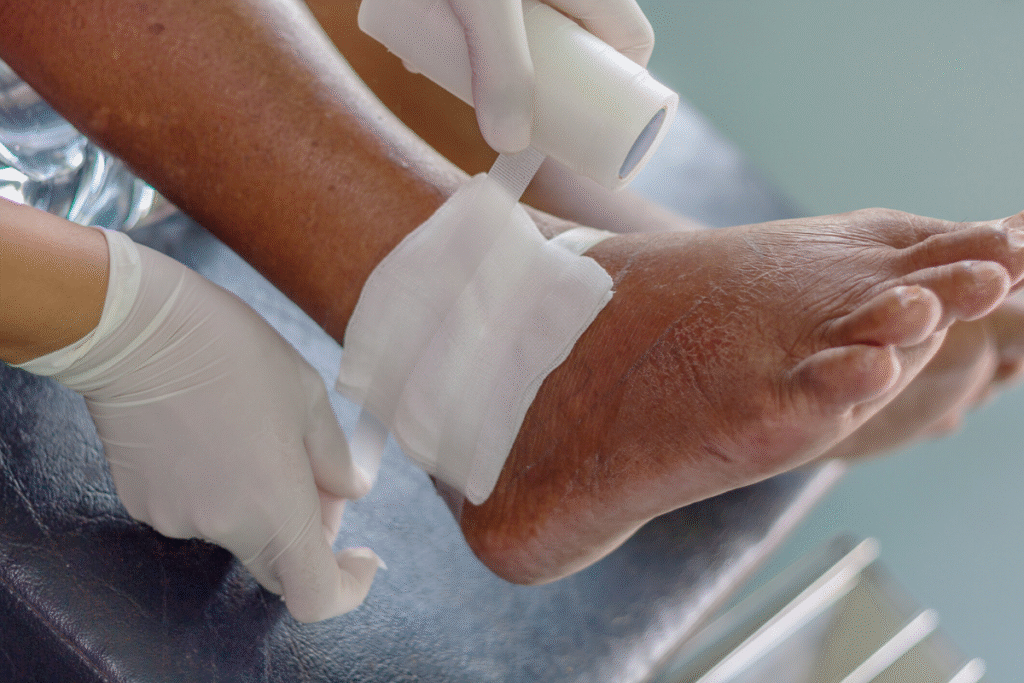Non-healing wounds are injuries that fail to heal within a typical timeframe, despite proper care. These wounds can cause discomfort, limit mobility, and increase the risk of infection or other complications. Common causes include diabetes, poor circulation, trauma, infections, and orthopedic conditions affecting bones and joints. Chronic wounds are particularly concerning because they can indicate underlying structural problems that slow healing. Orthopedic treatment for non-healing wounds focuses not only on the wound itself but also on the musculoskeletal factors that may impede recovery. Early intervention is critical to prevent further deterioration and improve quality of life. Understanding the causes and risk factors allows orthopedic specialists to provide targeted, effective care that promotes healing.
The Role of Orthopedic Intervention in Wound Healing
Orthopedic specialists play a key role in managing non-healing wounds by addressing musculoskeletal issues that may contribute to chronicity. Structural problems such as misaligned bones, joint instability, or previous fractures can create pressure points that prevent wounds from closing. Orthopedic treatment for non-healing wounds involves careful evaluation, including imaging studies and physical assessments, to identify these underlying issues. By correcting structural or alignment problems, orthopedic doctors can improve circulation, reduce mechanical stress on the wound, and support tissue regeneration. Coordination with other healthcare providers ensures that both the wound and the patient’s overall orthopedic health are addressed. A comprehensive approach enhances the likelihood of full recovery and long-term wound prevention.
Common Orthopedic Treatments for Non-Healing Wounds
Several orthopedic treatments can effectively promote healing in chronic wounds. Surgical interventions, including debridement, remove dead or infected tissue to encourage new tissue growth. Skin grafting and flap surgery may be necessary for wounds with significant tissue loss, creating a foundation for healing. Non-surgical strategies are also crucial, such as immobilization to protect the wound, pressure offloading to reduce stress on affected areas, and corrective procedures to address underlying structural issues. Advanced therapies like negative pressure wound therapy (NPWT) and bioengineered skin substitutes have shown excellent results in orthopedic treatment for non-healing wounds. Orthopedic specialists often combine multiple treatment modalities for optimal outcomes, ensuring that healing is efficient and sustainable.
Diagnostic Tools and Evaluation
Accurate evaluation is essential for effective orthopedic treatment for non-healing wounds. Imaging techniques such as X-rays, MRI, and CT scans can reveal hidden bone or joint issues that may interfere with healing. Laboratory tests help identify infections, poor circulation, or systemic health problems that complicate recovery. Orthopedic specialists track wound progression closely, adjusting treatment plans as needed. This ongoing monitoring prevents minor issues from becoming severe complications. By combining precise diagnostics with continuous observation, orthopedic treatment for non-healing wounds is tailored to each patient’s unique needs, improving the chance of successful recovery.
Preventive Measures and Rehabilitation
Preventive care is a vital aspect of orthopedic treatment for non-healing wounds. Patients at high risk, including those with diabetes, poor circulation, or orthopedic injuries, benefit from early consultations. Physical therapy improves circulation, strengthens muscles, and maintains joint mobility, which are all critical for wound healing. Lifestyle adjustments such as proper nutrition, smoking cessation, and consistent wound care at home further support recovery. Orthopedic specialists guide patients in preventive measures that address both immediate wounds and long-term musculoskeletal health. Rehabilitation not only facilitates healing but also helps patients regain functionality, reduce pain, and prevent future chronic wounds.
Multidisciplinary Care for Better Outcomes
Orthopedic treatment for non-healing wounds often involves collaboration with a multidisciplinary team. Podiatrists, vascular surgeons, wound care nurses, and infectious disease specialists work alongside orthopedic doctors to provide comprehensive care. This collaboration ensures that surgical, non-surgical, and therapeutic approaches are integrated effectively. Personalized care plans are developed based on the patient’s unique needs, combining multiple strategies to maximize recovery. Patient education is an essential component, teaching proper wound care and preventive strategies. Multidisciplinary care ensures that all aspects of wound management are addressed, significantly improving healing outcomes.
Patient Experiences and Expectations
Recovery from non-healing wounds varies depending on severity, location, and underlying conditions. Patients should maintain realistic expectations regarding pain, swelling, and temporary limitations in mobility. Orthopedic treatment for non-healing wounds often includes guidance on pain management, therapeutic exercises, and activity modifications to facilitate healing. Understanding potential complications and when to seek help is vital for safety and progress. Regular follow-up visits allow orthopedic specialists to adjust treatment plans as needed, ensuring optimal recovery. Active patient participation in care enhances results, improves confidence, and contributes to faster, more sustainable healing.
FAQ
What makes a wound “non-healing”?
A wound is considered non-healing when it does not close within the expected timeframe despite proper care. Causes may include poor circulation, diabetes, infection, or structural orthopedic issues.
When should I see an orthopedic specialist for a wound?
If a wound persists for several weeks without improvement, shows signs of infection, or is associated with bone or joint problems, an orthopedic consultation is recommended. Early intervention improves recovery outcomes.
Are non-surgical treatments effective for all patients?
Non-surgical treatments such as immobilization, pressure offloading, and advanced wound therapy are effective for many patients, but severe wounds or significant tissue loss may require surgical intervention.
How long does orthopedic treatment take for chronic wounds?
Healing time depends on wound severity, location, and underlying conditions. Minor wounds may heal in weeks, while complex wounds may require several months of treatment.
Can non-healing wounds lead to serious complications if untreated?
Yes, untreated wounds can result in infection, tissue death, bone infection (osteomyelitis), or systemic complications. Timely orthopedic treatment minimizes these risks and promotes healing.

